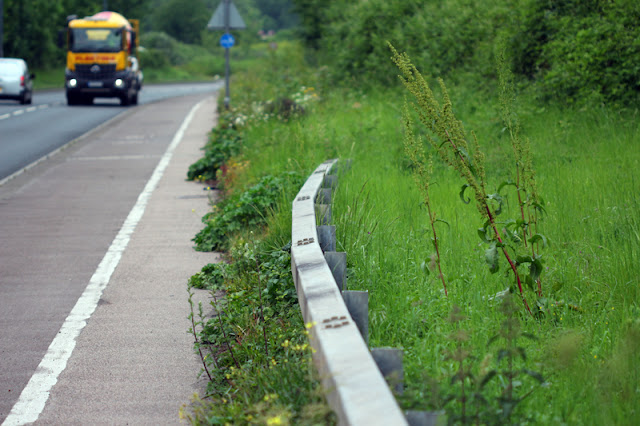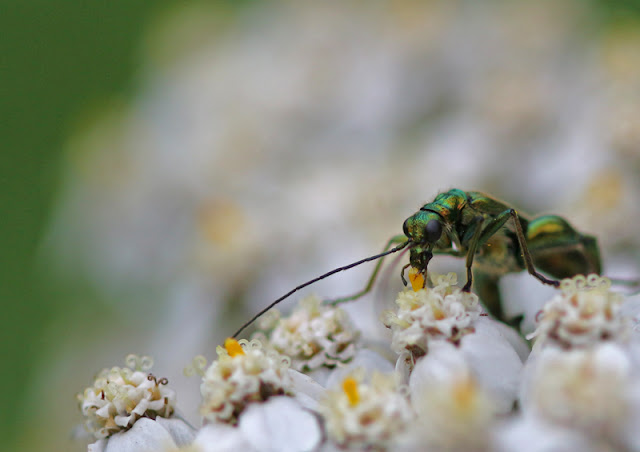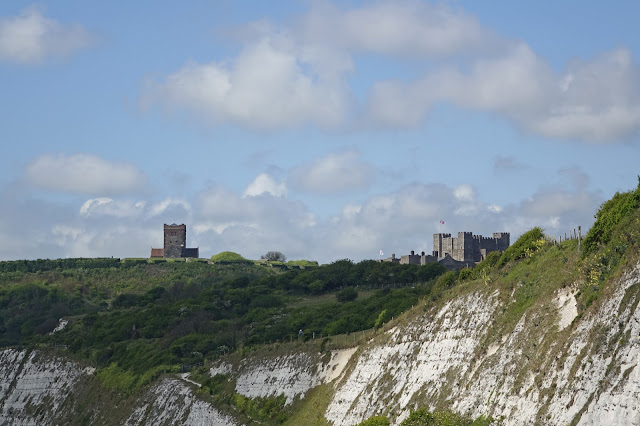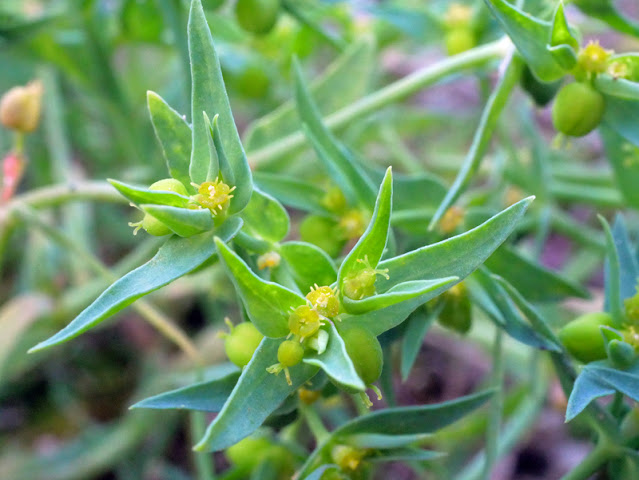Urban Botany, Northfleet, Kent 17/05/17
TQ6273 is a grid square that covers much of the south of Northfleet, an urban/industrial area in North Kent. It had hardly any botanical records, so this day I set out to see what I could find.
Much of the area comprises of houses and industrial estates (all kept neat and tidy) but a relatively new road now runs through what was an alkaline fen over chalk, so I concentrated on that area.
It doesn't look too inviting does it! However, verges were wide on both sides of the road and largely left wild so I began my search.
Near the industrial estate was a grassy area and within it I found these Bur Chervil plants both in flower and in seed.
They look very similar at first to Cow Parsley, but the former are mostly only a few inches tall. The seeds are also totally different to Cow Parsley so it's easy to identify it.
Anthriscus caucalis
I found several other species in the grass such as one would expect such as Spotted Medick, Daisy, Dandelion, Lesser Trefoil and so on.
Also on a rough grass verge were numerous Musk Storksbill, a relatively recent arrival in the UK.
Erodium moschatum
It's quite a big bigger than Common Storkbill with taller multiple flower heads and big glandular hairy leaves. If you rub a finger over the leaves you get a gone off lemon smell.
As I made my way along the road verge there was a surprising number of species flowering, all attracting butterflies, moths, beetles and other insects that rely on nectar and pollen.
Here's a Green-veined White butterfly feeding on a Hawksbeard.
Yarrow is a plentiful and common plant, but now some is coming into flower. Each flower is actually a head of numerous single florets grouped together and the insects love it, like this Swollen -thighed Beetle.
Achillea millefolium
Common Mallow really is common unlike many plants that bear common in their names. It's always worth keeping an eye out for Mallows as there are different species to find such as Dwarf, Tree, Musk and Marsh.
Malva sylvestris
All Brambles aren't Brambles!
There were masses of Dewberry plants in flower. Their big, all white flowers, and 3 leaflets with weak prickles on the stems give them away. In fruit, the fruit is dark with a white almost milldew looking covering and again are easy to spot then.
Rubus caesius
Goatsbeard was common along the road verge. Its big long bracts close up as the afternoon wears on. It's also called Jack-go-to-bed-at-noon which is when it starts to close.
They're big tall plants with a single flower on top of a long stem so cannot be confused with other Dandelion looking plants.
Tragopogon pratensis
If you find a purple version of this plant, it's the garden escape called Salsify. There's lots of that near Rye, East Sussex.
This is Red Valerian which also comes with white or pink flowers. It's a naturalised non native plant and is found pretty much everywhere now.
Centranthus ruber
There were quite a few butterflies here but most I failed to photograph. Slipstream from passing lorries didn't help my photographic opportunities much!
Here's a Common Blue that I did catch up with.
There were plenty of these Common Vetch around with their two tone bright flowers sparkling in the greenery.
Vicia sativa spp segetalis
This plant was a big surprise and one I hadn't seen before. It's an obvious garden escape but it was behind a razor wire fence with a chalk cliff behind and covered over by Buddleja and Dogwood, so couldn't have been dumped or planted there.
It's a Gladioli which I'm sure all my gardening followers know already!
Gladiolus byzantinus
Of course, I was saving the best to last. On the North verge (so facing South) I found several hundred of the rare Yellow Vetchling which is a Kent Rare Plant Register species.
It has the most odd and easily identifiable leaves which are actually bracts. The leaves have evolved into tendrils!
Lathyrus aphaca
All in, I added 100 botanical records on my visit, with most of those being new records for the area. So, don't write off urban areas as being dull or not worth a visit, it can be fun and varied.
Just be careful of the roads!
Regards
Dave
@Barbus59
Much of the area comprises of houses and industrial estates (all kept neat and tidy) but a relatively new road now runs through what was an alkaline fen over chalk, so I concentrated on that area.
It doesn't look too inviting does it! However, verges were wide on both sides of the road and largely left wild so I began my search.
Near the industrial estate was a grassy area and within it I found these Bur Chervil plants both in flower and in seed.
They look very similar at first to Cow Parsley, but the former are mostly only a few inches tall. The seeds are also totally different to Cow Parsley so it's easy to identify it.
Anthriscus caucalis
I found several other species in the grass such as one would expect such as Spotted Medick, Daisy, Dandelion, Lesser Trefoil and so on.
Also on a rough grass verge were numerous Musk Storksbill, a relatively recent arrival in the UK.
Erodium moschatum
It's quite a big bigger than Common Storkbill with taller multiple flower heads and big glandular hairy leaves. If you rub a finger over the leaves you get a gone off lemon smell.
As I made my way along the road verge there was a surprising number of species flowering, all attracting butterflies, moths, beetles and other insects that rely on nectar and pollen.
Here's a Green-veined White butterfly feeding on a Hawksbeard.
Yarrow is a plentiful and common plant, but now some is coming into flower. Each flower is actually a head of numerous single florets grouped together and the insects love it, like this Swollen -thighed Beetle.
Achillea millefolium
There was a surprising number of chalk grassland plants doing well here, such as Yellow-wort, Marjoram and plenty of Hedge Bedstraw. When it has to compete it can grow to several feet in height scrambling around other vegetation to get to the light. On short chalk turf it can be just a few inches in height.
Galium album
Common Mallow really is common unlike many plants that bear common in their names. It's always worth keeping an eye out for Mallows as there are different species to find such as Dwarf, Tree, Musk and Marsh.
Malva sylvestris
All Brambles aren't Brambles!
There were masses of Dewberry plants in flower. Their big, all white flowers, and 3 leaflets with weak prickles on the stems give them away. In fruit, the fruit is dark with a white almost milldew looking covering and again are easy to spot then.
Rubus caesius
Goatsbeard was common along the road verge. Its big long bracts close up as the afternoon wears on. It's also called Jack-go-to-bed-at-noon which is when it starts to close.
They're big tall plants with a single flower on top of a long stem so cannot be confused with other Dandelion looking plants.
Tragopogon pratensis
If you find a purple version of this plant, it's the garden escape called Salsify. There's lots of that near Rye, East Sussex.
This is Red Valerian which also comes with white or pink flowers. It's a naturalised non native plant and is found pretty much everywhere now.
Centranthus ruber
There were quite a few butterflies here but most I failed to photograph. Slipstream from passing lorries didn't help my photographic opportunities much!
Here's a Common Blue that I did catch up with.
There were plenty of these Common Vetch around with their two tone bright flowers sparkling in the greenery.
Vicia sativa spp segetalis
This plant was a big surprise and one I hadn't seen before. It's an obvious garden escape but it was behind a razor wire fence with a chalk cliff behind and covered over by Buddleja and Dogwood, so couldn't have been dumped or planted there.
It's a Gladioli which I'm sure all my gardening followers know already!
Gladiolus byzantinus
Of course, I was saving the best to last. On the North verge (so facing South) I found several hundred of the rare Yellow Vetchling which is a Kent Rare Plant Register species.
It has the most odd and easily identifiable leaves which are actually bracts. The leaves have evolved into tendrils!
Lathyrus aphaca
All in, I added 100 botanical records on my visit, with most of those being new records for the area. So, don't write off urban areas as being dull or not worth a visit, it can be fun and varied.
Just be careful of the roads!
Regards
Dave
@Barbus59




















Comments
Post a Comment
Comments welcome from those interested in my articles. For spammers don't bother as I moderate all comments prior to posting them.